
The renewed drive to keep fit is perhaps one of the best things we’ve come to embrace in today’s society. While there are those among us who still see going to the gym, or even simply maintaining a fitness regimen, as a status symbol or something people flaunt to seem impressive or noteworthy, most of us know better. We understand the human body more these days than ever, and people have mostly shed the stigma that would undermine the effectiveness of pursuing this sort of exercise so ardently. Whether it’s yoga, a gym routine or just running, people have found something that they can turn to in order to blow off steam, keep going, and stay healthy.
However, sometimes untoward results are inevitable, and injuries can comprise this to an extent. For instance, runners, basketball players, and gymnasts, among others, can encounter calf strain, which is a seemingly small thing that can put enough of a damper on things to keep them from returning to running for some time. Calf strain tends to take the form of a sharp pain in the lower leg, specifically muscle behind your knee and shin. While calf muscle strain sounds simple, the name itself could be arguably said to be a misnomer – there is no single calf muscle, but instead a group of up to nine muscles working together. It’s not one of the biggest, most prevalent injuries, but it’s far from unfelt – at least one study shows that 13% of professional soccer players studied experienced it, and while global statistics are minimal, the odds are good that it isn’t just them.
Sometimes calf strain can be traced to damage sustained by the soleus muscle, or the larger gastrocnemius muscle. Usually, however, calf strain can be traced to the muscular tendinuous junction where the Achilles tendon meets the above muscles. Overstretching or tearing the muscles here, which can occur in sudden jumps or direction changes, or perhaps taxing them without having warmed them up, can bring on calf strain. It’s worth noting that while calf strain can occur suddenly – usually signaled with a popping sound – it can also occur gradually over time. Calf strain is usually felt as a sharp pain in that part of the leg, making the muscle tender to the touch. The pain may come when the muscle is moved, or even when it is at rest, usually in the form of throbbing or spasms. Some tightness or weakness in the area, and bruising and swelling, might be observed as well, and the pain can be bad enough to make even walking unbearable, let alone other tasks that involve the calf muscle group such as climbing stairs.
So how can you recover from a calf strain? Checking in with a physician immediately can do a lot to keep things from getting even worse. A physical therapist will probably address the issue in the first 24 to 48 hours by advising you to rest the affected area, keeping it on ice at intervals and elevated where possible. Compression, usually in the form of an elastic bandage wrap, may also be recommended. Even heel lift pads may be recommended for your shoes to reduce the stress put on that muscle group. Surgery is rarely a necessity for calf strains unless it’s particularly severe.
The aforementioned step of compression is particularly seen to have potentially beneficial effects because it can help increase blood flow in the area and keep it efficient enough to clear metabolic waste and refresh the affected muscles. Calf compression socks are particularly notable for allowing improvement in this particular aspect of one’s well-being. Furthermore, these can be helpful when it comes to traveling or having long periods of standing or sitting that could otherwise produce more pain or stress. Aside from applying ice to the area you can also apply heat, which could also help increase blood flow in the area as well.
We hope that these calf strain recovery tips will help you bounce back from it faster. For more information on our Copper Infused Compression Sleeves, Click Here!